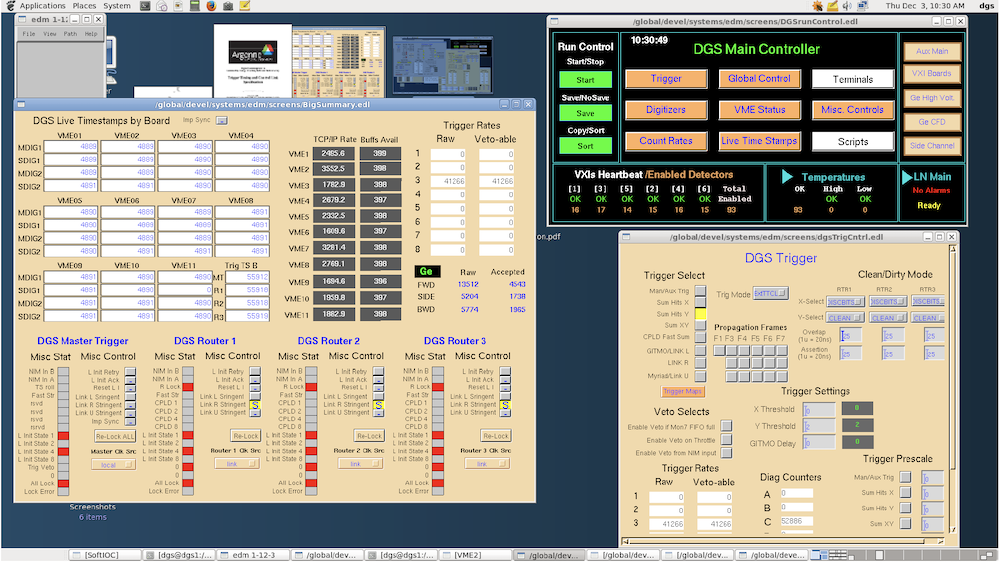User Guides for Experiments: Difference between revisions
No edit summary |
No edit summary |
||
| Line 10: | Line 10: | ||
*TCP/IP rates (center grey boxes) should be changing, and Buffs Avail should be <400 when data is being written to disk. | *TCP/IP rates (center grey boxes) should be changing, and Buffs Avail should be <400 when data is being written to disk. | ||
*VME 01-11 (left white boxes) show values that change in MDIG(n) and SDIG(n) fields. These are Timestamps that should be very close in value when digitizers are all Locked. | *VME 01-11 (left white boxes) show values that change in MDIG(n) and SDIG(n) fields. These are Timestamps that should be very close in value when digitizers are all Locked. | ||
*Trigger Rate (bottom right) should be <50 kHz running in "singles" multiplicity (X Threshold = 0). TRIGGER RATE VARIES BY EXPERIMENT DEPENDING ON MULTIPLICITY, BEAM INTENSITY, AND OTHER FACTORS. | |||
The second desktop in the above image (bottom right button) has several white terminal windows, one for each VME (IOC receiver), plus a terminal window with a dgs@dgs1 prompt for start/stop commands. Each VME terminal should update every 15 seconds showing the data in Mb/sec written to disk. | |||
==== Actions During Shift ==== | |||
It is highly recommended to start a new run approximately every hour. If there is an incident that results in corrupt data for that run, less data would be lost. | |||
In /dgsdata directory, stop the current run | |||
./stop_run.sh | |||
Wait 5-10 sec for all Buffs Avail to display 400 in the Big Summary | |||
./start_run.sh ### | |||
where ### is the next run number. | |||
Log in the logbook or elog the stop/start times, current trigger rate, and beam current (or no change in beam current). If you have been advised to check the capacity of the current disk type | |||
df -h | |||
==== When VME(s) Crash ==== | |||
The first indication of a VME crashing is the TCP/IP rate drops to 0.0 and Buffs Avail continuously fall below 380 without recovering on their own. Stopping the current run and starting a new run before the Buffs Avail reach zero can prevent a crash. If Buffs Avail fall to 0.0, that VME has crashed and needs to be restarted. Check the terminal windows of the IOC receivers and look for an error message (ie something other than Mb/sec written to disk). | |||
First, stop the current run. Then, attempt to reboot the affected receiver. | |||
''Go back to [[Digital Gammasphere and the SBX Upgrade]]'' | ''Go back to [[Digital Gammasphere and the SBX Upgrade]]'' | ||
Revision as of 17:20, September 24, 2021
Experiment Run Procedures
For directory structure, energy and pole/zero calibration see typical DGS run procedures.
Digital Gammasphere Shift Notes
This section provides a walkthrough of a typical 8-hour shift using DGS. The main workspace looks like this:
General Things to Watch
- Run Control box in DGS Main Controller (top right) must show "Start; Save; Sort" during a run. Otherwise, data is not being recorded.
- TCP/IP rates (center grey boxes) should be changing, and Buffs Avail should be <400 when data is being written to disk.
- VME 01-11 (left white boxes) show values that change in MDIG(n) and SDIG(n) fields. These are Timestamps that should be very close in value when digitizers are all Locked.
- Trigger Rate (bottom right) should be <50 kHz running in "singles" multiplicity (X Threshold = 0). TRIGGER RATE VARIES BY EXPERIMENT DEPENDING ON MULTIPLICITY, BEAM INTENSITY, AND OTHER FACTORS.
The second desktop in the above image (bottom right button) has several white terminal windows, one for each VME (IOC receiver), plus a terminal window with a dgs@dgs1 prompt for start/stop commands. Each VME terminal should update every 15 seconds showing the data in Mb/sec written to disk.
Actions During Shift
It is highly recommended to start a new run approximately every hour. If there is an incident that results in corrupt data for that run, less data would be lost. In /dgsdata directory, stop the current run
./stop_run.sh
Wait 5-10 sec for all Buffs Avail to display 400 in the Big Summary
./start_run.sh ###
where ### is the next run number.
Log in the logbook or elog the stop/start times, current trigger rate, and beam current (or no change in beam current). If you have been advised to check the capacity of the current disk type
df -h
When VME(s) Crash
The first indication of a VME crashing is the TCP/IP rate drops to 0.0 and Buffs Avail continuously fall below 380 without recovering on their own. Stopping the current run and starting a new run before the Buffs Avail reach zero can prevent a crash. If Buffs Avail fall to 0.0, that VME has crashed and needs to be restarted. Check the terminal windows of the IOC receivers and look for an error message (ie something other than Mb/sec written to disk).
First, stop the current run. Then, attempt to reboot the affected receiver.
Go back to Digital Gammasphere and the SBX Upgrade
